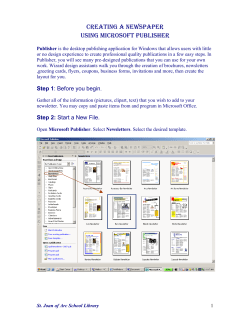
C N D RY OMMUNICATIO
COMMUNICATION DIRECTORY Newsletter for Corporate Communications and Public Relations August 2011 HOW TO CHOOSE THE RIGHT WEAPON Social media represent both a catalyst for and a weapon against brand crises. Communicators should know the right approach to take by Peter Kerkhof, Friederike Schultz and Sonja Utz T he BP oil spill and the Toyota recall crisis once again document that organisational crises pose a major threat to brands. Crises frequently lead to negative word-of-mouth, which in turn may result in substantial financial losses for corporations. An important but challenging task of corporate communication departments is timely and adequate reaction when a crisis occurs. Different stakeholder groups, such as consumers, investors, political actors or the general public, have different interests in the corporation, which makes it hard to react in an adequate manner. Increasingly, organisational crises and corporate interventions take place in social media such as Twitter, Facebook or weblogs, presenting brands with new choices about what to say, where to say it and how to say it. WHAT TO SAY: SITUATIONAL CRISIS COMMUNICATION Research on crisis communication has mainly focused on the question of what to say during an organisational crisis and has typically compared the effects of different crisis communication strategies on consumers or, more generally, the public. The most popular approach is the so called ‘situational crisis communication theory’, or SCCT (as formulated by W.T. Coombs in “Protecting Organisation Reputation During a Crisis”, Corporate Reputation Review, 10(3), 2007). SCCT distinguishes several categories of crises, such as accidental or intentional crises, and argues that the success of a crisis response strategy (e.g., apologising, showing sympathy, or providing information) depends on the type of crisis and perceived crisis responsibility. For example, in case of a crisis for which the organisation has little responsibility (e.g. cancellation of flights due to the ash cloud), informing the public might be enough.The danger of brands being damaged by a crisis has Newsletter Editors Graphics Publishers Dafydd Phillips, Steffi Butter Rudolf Hetzel, Neil Cranswick Marc-Oliver Voigt increased with the recent rise of social media. Social media pose a serious challenge to corporate communication departments because of the high speed of information transfer, and the interactivity and the public character of both the consumer and corporate responses. At the same time, social media present opportunities to corporations. In traditional media environments, corporations need to build media relations with journalists in order to inform the public and respond to critical concerns. In social media environments, organisations can communicate directly with their stakeholders. Therefore communication departments increasingly do not only issue classic press releases, but use social media such as Facebook, organisational blogs or Twitter to communicate with their stakeholders (as both BP and Toyota did recently). However, the art of communicating using social media is different from the art of writing a press release. Whereas journalists can be expected to focus on the substance of a crisis response, for the larger audience the way a response is formulated and the medium through which the message is delivered may affect their immediate reactions. Below we present evidence from two studies that strongly suggest that the effects of ‘where’ and ‘how’ to communicate may be as powerful as the effect of ‘what’ companies say as a response to an organisational crisis. WHERE TO SAY IT: THE CHOICE OF MEDIA CHANNEL MATTERS In “Is the medium the message? Perceptions of and reactions to crisis communication via twitter, blogs and traditional media” (Public Relations Review, 37(1), 2011), F. Schultz, S. Utz and A. Göritz examined whether or not it matters which channels are used to spread crisis responses by comparing the effects of various crisis response strategies (apology, sympathy, information) sent through different media READ MORE channels (e.g., apologising, showing sympathy, Send your Personnel News updates to personnel@communication-director.eu Follow Communication Director: Now On Twitter! ����� ���������������� COMMUNICATION DIRECTORY Newsletter for Corporate Communications and Public Relations August 2011 Gain international recognition for your PR work and celebrate with Europe’s communications community at the ���� ��������������������� � � � � � � � � � � � � � � ��� ������������� � � � � � � � � � � � � � � � � �� ��������� ���� � � ��� ��� ������������ � � � ��� ��� ��� ������������ � 2 COMMUNICATION DIRECTORY Newsletter for Corporate Communications and Public Relations August 2011 FACTS & FIGURES A new report by Wolfstar Consultancy examines how companies in the FTSE Global 500 2010 use social media and social networks to support their corporate social responsibility activities. Undertaken between September 2010 and May this year, it analyses the visible online social web activity of all 500 companies. Out of the 500, the report identifies only 46 companies “that appear to be using social media to both communicate and support their corporate social responsibility strategy”, ranging from Microsoft to Aviva. The platforms and techniques used most frequently are RSS and embedded video, used almost ubiquitously across the 46 (below left). The report notes the preference for embedded video over YouTube and the low number in favour of podcasts. The report profiles each of the 46 companies, clearly comparing their interactive and shareable content in an easy-to-reference guide. The report is also worth reading for its insightful case studies of how NGOs use social media, using the examples as models for how companies could harness social media into their own CSR strategies. It also provides a handy overview of how the 500 companies are dispersed internationally (below right). Of the 46 companies, 44 per cent are based in the US, followed by Germany and the UK with 11 per cent each, France with nine per cent and Denmark with five per cent. However – and perhaps surprisingly, given the US’s role as social media pioneer – Europe accounts for slightly more of the active companies than North America, even though North America has more FTSE 500 companies overall. Taken from Wolfstar Consultancy, The Global Social READ MORE Media and CSR Report 2011 Platforms Social countries 36 37 Brazil 1% 28 19 20 Denmark 2% France 4% 22 Germany 5% India 2% Japan 1% South Africa 1% South Korea 1% Spain 2% 3 Podcast Switzerland 2% Facebook Blog YouTube Twitter RSS UK 5% Embedded Video US 20% Source: The Global Social Media and CSR Report Advertising A PART-TIME PROGRAM FOR EXPERIENCED PROFESSIONALS Take your communications career to the next level ting Star ry a Janu 2012 A joint program with: In cooperation with: INFORMATION MEETINGS Zurich May 16 | June 6 | September 12 | October 10 | Stockholm May 12-13 | Brussels June 30-July 1 | Los Angeles July 18-28 | Berlin September 15-16 Individual meetings are held throughout Europe. www.mscom.usi.ch 3 COMMUNICATION DIRECTORY Newsletter for Corporate Communications and Public Relations August 2011 Recent Appointments from the World of Communications / August 2011 PERSONNEL UK: News of change at Shell and BG Group Stuart Bruseth has left his position as vice president of global media relations at Royal Dutch Shell in order to become communications director at FTSE 100 energy firm BG Group. He will replace Matt Peacock, who has joined the Vodafone Group as communications director, as reported here in June. Stuart Bruseth (Communications Director) Institution: BG Group Denmark: ATV hires communications director ATV has hired Jakob Werner as its new communications director: the appointment is part of ATV’s new strategy to focus more on the environment. Werner was previously a communications consultant at KommunikationsKompagniet, where over the past eighteen months he advised the European Commission on media relations and stakeholder communications. Jakob Werner (Communications Director) Institution: ATV Start: August 15 Germany: Pape leads communications at Talanx Deutschland Tatjana Pape is the new Head of Communications at Talanx Deutschland. In this new position, she is responsible for the product communication of the insurance company’s retail, commercial and business insurance services. Pape has replaced Hubert Becker, who left the company, and reports to board member Iris Klunk. Tatjana Pape (Head of Communications) Institution: Talanx Deutschland Start: August 01 READ MORE EVENTS 01.09.2011 Lac Leman Communications Forum 2011 20.09.2011 Healthcare & Pharmaceutical Comms Congress 2011 How can communicators earn a leadership role and become part of the executive team? This forum will bring to bear the latest research and best practices around communication and leadership. USI Università della Svizzera italiana/HarbourClub/SRRP This congress will explore the facets of a robust communications strategy attuned to the evolving healthcare environment. Featured speakers include figures from Johnson & Johnson, AstraZeneca and the Financial Times. PR Week, London READ MORE READ MORE 29.09.2011 ICCO Summit 2011 30.09.2011 Digital Communication Awards The ICCO Summit pulls together senior practitioners from PR consultancies around the world to explore the issues and trends affecting the industry. Under the banner “PR Takes the Lead: The Industry in 2020”, this event looks ahead to what the future may hold. ICCO, Sintra, Portugal Over the last few years, the field of professional communication has experienced a significant change: digital communication has become one of the fastest growing and most innovative sectors.The inaugural Digital Communication Awards celebrates this growth. Quadriga University, Berlin READ MORE READ MORE
© Copyright 2025





















